Taxation Law HI3042 T2 2017: Individual Assignment Analysis
VerifiedAdded on 2020/03/16
|11
|1521
|33
Homework Assignment
AI Summary
This document presents a comprehensive solution to a taxation law assignment (HI3042). It addresses several key areas of Australian taxation, including the deductibility of business expenses under s. 8(1) of the ITAA 1997, analyzing whether expenses related to asset relocation, legal fees for winding up, and solicitor services for business operations are deductible. The assignment also examines input tax credits, specifically focusing on GST implications for advertising expenses, and determines the extent to which Big Bank can claim input tax credits. Furthermore, the solution outlines the calculation of foreign tax offsets for an Australian tax resident (Angelo) who has earned foreign income and paid taxes abroad. Finally, the assignment concludes with the determination of taxable income for a partnership firm, detailing the calculation of assessable income, deductible expenses, and the resulting taxable income. References to relevant tax law and publications support the analysis.
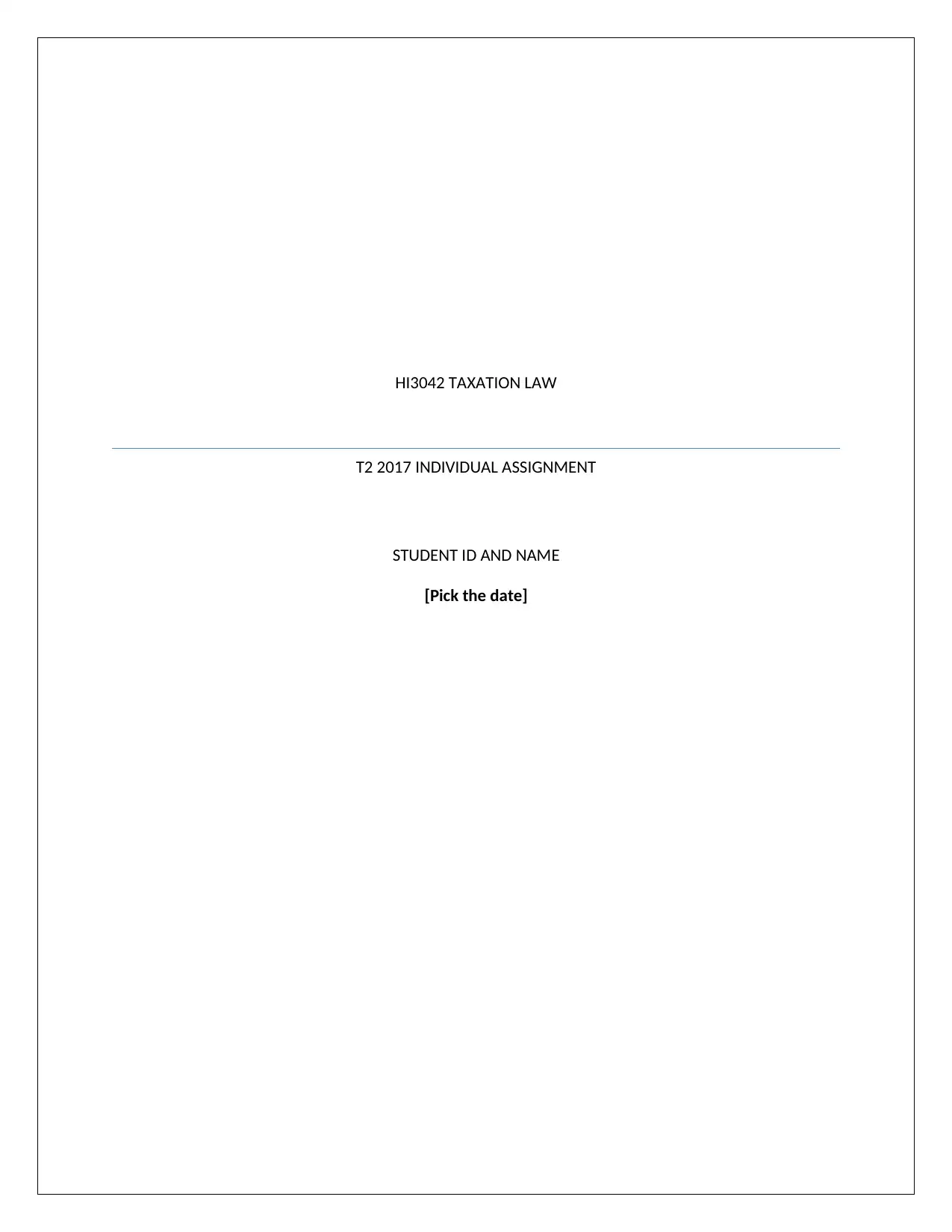
HI3042 TAXATION LAW
T2 2017 INDIVIDUAL ASSIGNMENT
STUDENT ID AND NAME
[Pick the date]
T2 2017 INDIVIDUAL ASSIGNMENT
STUDENT ID AND NAME
[Pick the date]
Paraphrase This Document
Need a fresh take? Get an instant paraphrase of this document with our AI Paraphraser
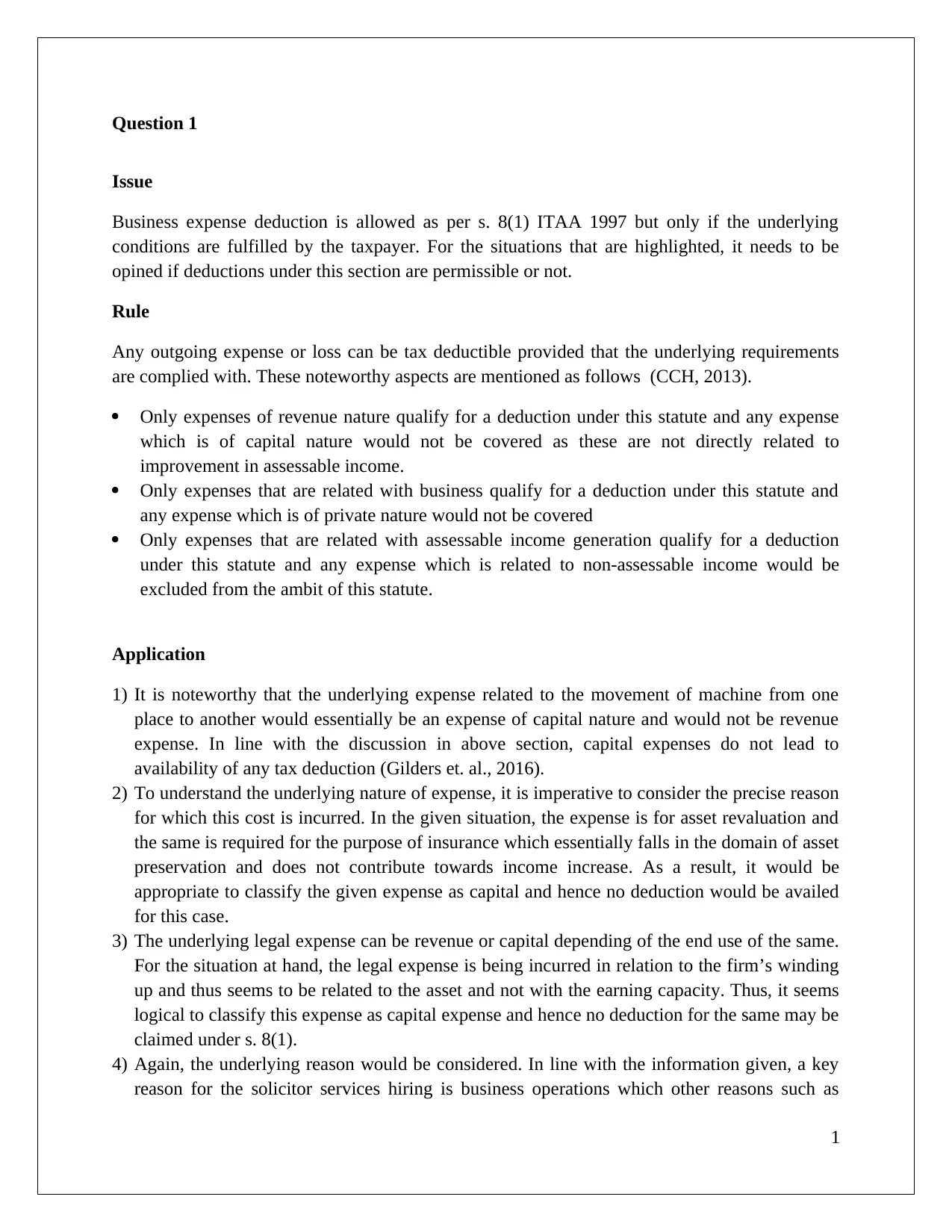
Question 1
Issue
Business expense deduction is allowed as per s. 8(1) ITAA 1997 but only if the underlying
conditions are fulfilled by the taxpayer. For the situations that are highlighted, it needs to be
opined if deductions under this section are permissible or not.
Rule
Any outgoing expense or loss can be tax deductible provided that the underlying requirements
are complied with. These noteworthy aspects are mentioned as follows (CCH, 2013).
Only expenses of revenue nature qualify for a deduction under this statute and any expense
which is of capital nature would not be covered as these are not directly related to
improvement in assessable income.
Only expenses that are related with business qualify for a deduction under this statute and
any expense which is of private nature would not be covered
Only expenses that are related with assessable income generation qualify for a deduction
under this statute and any expense which is related to non-assessable income would be
excluded from the ambit of this statute.
Application
1) It is noteworthy that the underlying expense related to the movement of machine from one
place to another would essentially be an expense of capital nature and would not be revenue
expense. In line with the discussion in above section, capital expenses do not lead to
availability of any tax deduction (Gilders et. al., 2016).
2) To understand the underlying nature of expense, it is imperative to consider the precise reason
for which this cost is incurred. In the given situation, the expense is for asset revaluation and
the same is required for the purpose of insurance which essentially falls in the domain of asset
preservation and does not contribute towards income increase. As a result, it would be
appropriate to classify the given expense as capital and hence no deduction would be availed
for this case.
3) The underlying legal expense can be revenue or capital depending of the end use of the same.
For the situation at hand, the legal expense is being incurred in relation to the firm’s winding
up and thus seems to be related to the asset and not with the earning capacity. Thus, it seems
logical to classify this expense as capital expense and hence no deduction for the same may be
claimed under s. 8(1).
4) Again, the underlying reason would be considered. In line with the information given, a key
reason for the solicitor services hiring is business operations which other reasons such as
1
Issue
Business expense deduction is allowed as per s. 8(1) ITAA 1997 but only if the underlying
conditions are fulfilled by the taxpayer. For the situations that are highlighted, it needs to be
opined if deductions under this section are permissible or not.
Rule
Any outgoing expense or loss can be tax deductible provided that the underlying requirements
are complied with. These noteworthy aspects are mentioned as follows (CCH, 2013).
Only expenses of revenue nature qualify for a deduction under this statute and any expense
which is of capital nature would not be covered as these are not directly related to
improvement in assessable income.
Only expenses that are related with business qualify for a deduction under this statute and
any expense which is of private nature would not be covered
Only expenses that are related with assessable income generation qualify for a deduction
under this statute and any expense which is related to non-assessable income would be
excluded from the ambit of this statute.
Application
1) It is noteworthy that the underlying expense related to the movement of machine from one
place to another would essentially be an expense of capital nature and would not be revenue
expense. In line with the discussion in above section, capital expenses do not lead to
availability of any tax deduction (Gilders et. al., 2016).
2) To understand the underlying nature of expense, it is imperative to consider the precise reason
for which this cost is incurred. In the given situation, the expense is for asset revaluation and
the same is required for the purpose of insurance which essentially falls in the domain of asset
preservation and does not contribute towards income increase. As a result, it would be
appropriate to classify the given expense as capital and hence no deduction would be availed
for this case.
3) The underlying legal expense can be revenue or capital depending of the end use of the same.
For the situation at hand, the legal expense is being incurred in relation to the firm’s winding
up and thus seems to be related to the asset and not with the earning capacity. Thus, it seems
logical to classify this expense as capital expense and hence no deduction for the same may be
claimed under s. 8(1).
4) Again, the underlying reason would be considered. In line with the information given, a key
reason for the solicitor services hiring is business operations which other reasons such as
1
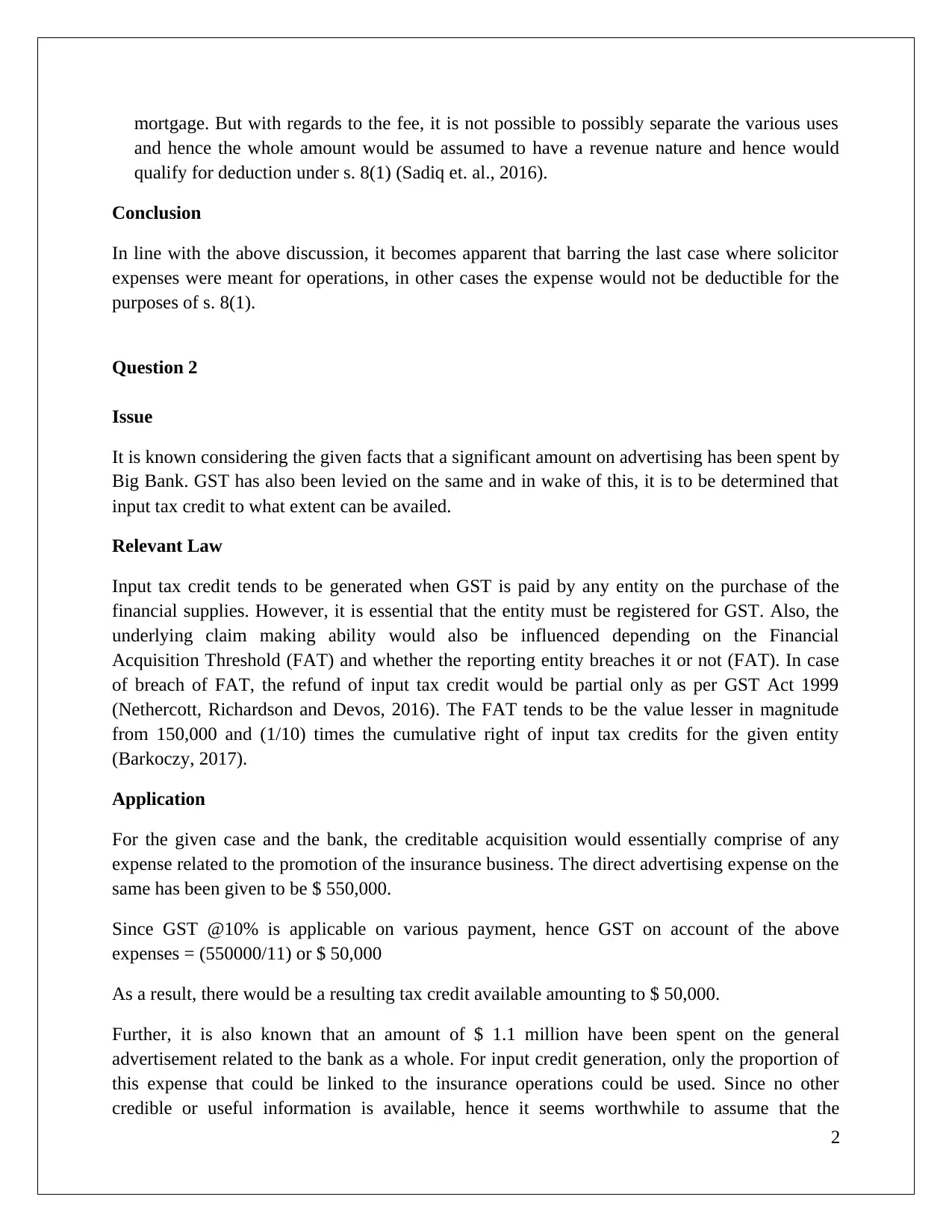
mortgage. But with regards to the fee, it is not possible to possibly separate the various uses
and hence the whole amount would be assumed to have a revenue nature and hence would
qualify for deduction under s. 8(1) (Sadiq et. al., 2016).
Conclusion
In line with the above discussion, it becomes apparent that barring the last case where solicitor
expenses were meant for operations, in other cases the expense would not be deductible for the
purposes of s. 8(1).
Question 2
Issue
It is known considering the given facts that a significant amount on advertising has been spent by
Big Bank. GST has also been levied on the same and in wake of this, it is to be determined that
input tax credit to what extent can be availed.
Relevant Law
Input tax credit tends to be generated when GST is paid by any entity on the purchase of the
financial supplies. However, it is essential that the entity must be registered for GST. Also, the
underlying claim making ability would also be influenced depending on the Financial
Acquisition Threshold (FAT) and whether the reporting entity breaches it or not (FAT). In case
of breach of FAT, the refund of input tax credit would be partial only as per GST Act 1999
(Nethercott, Richardson and Devos, 2016). The FAT tends to be the value lesser in magnitude
from 150,000 and (1/10) times the cumulative right of input tax credits for the given entity
(Barkoczy, 2017).
Application
For the given case and the bank, the creditable acquisition would essentially comprise of any
expense related to the promotion of the insurance business. The direct advertising expense on the
same has been given to be $ 550,000.
Since GST @10% is applicable on various payment, hence GST on account of the above
expenses = (550000/11) or $ 50,000
As a result, there would be a resulting tax credit available amounting to $ 50,000.
Further, it is also known that an amount of $ 1.1 million have been spent on the general
advertisement related to the bank as a whole. For input credit generation, only the proportion of
this expense that could be linked to the insurance operations could be used. Since no other
credible or useful information is available, hence it seems worthwhile to assume that the
2
and hence the whole amount would be assumed to have a revenue nature and hence would
qualify for deduction under s. 8(1) (Sadiq et. al., 2016).
Conclusion
In line with the above discussion, it becomes apparent that barring the last case where solicitor
expenses were meant for operations, in other cases the expense would not be deductible for the
purposes of s. 8(1).
Question 2
Issue
It is known considering the given facts that a significant amount on advertising has been spent by
Big Bank. GST has also been levied on the same and in wake of this, it is to be determined that
input tax credit to what extent can be availed.
Relevant Law
Input tax credit tends to be generated when GST is paid by any entity on the purchase of the
financial supplies. However, it is essential that the entity must be registered for GST. Also, the
underlying claim making ability would also be influenced depending on the Financial
Acquisition Threshold (FAT) and whether the reporting entity breaches it or not (FAT). In case
of breach of FAT, the refund of input tax credit would be partial only as per GST Act 1999
(Nethercott, Richardson and Devos, 2016). The FAT tends to be the value lesser in magnitude
from 150,000 and (1/10) times the cumulative right of input tax credits for the given entity
(Barkoczy, 2017).
Application
For the given case and the bank, the creditable acquisition would essentially comprise of any
expense related to the promotion of the insurance business. The direct advertising expense on the
same has been given to be $ 550,000.
Since GST @10% is applicable on various payment, hence GST on account of the above
expenses = (550000/11) or $ 50,000
As a result, there would be a resulting tax credit available amounting to $ 50,000.
Further, it is also known that an amount of $ 1.1 million have been spent on the general
advertisement related to the bank as a whole. For input credit generation, only the proportion of
this expense that could be linked to the insurance operations could be used. Since no other
credible or useful information is available, hence it seems worthwhile to assume that the
2
⊘ This is a preview!⊘
Do you want full access?
Subscribe today to unlock all pages.

Trusted by 1+ million students worldwide
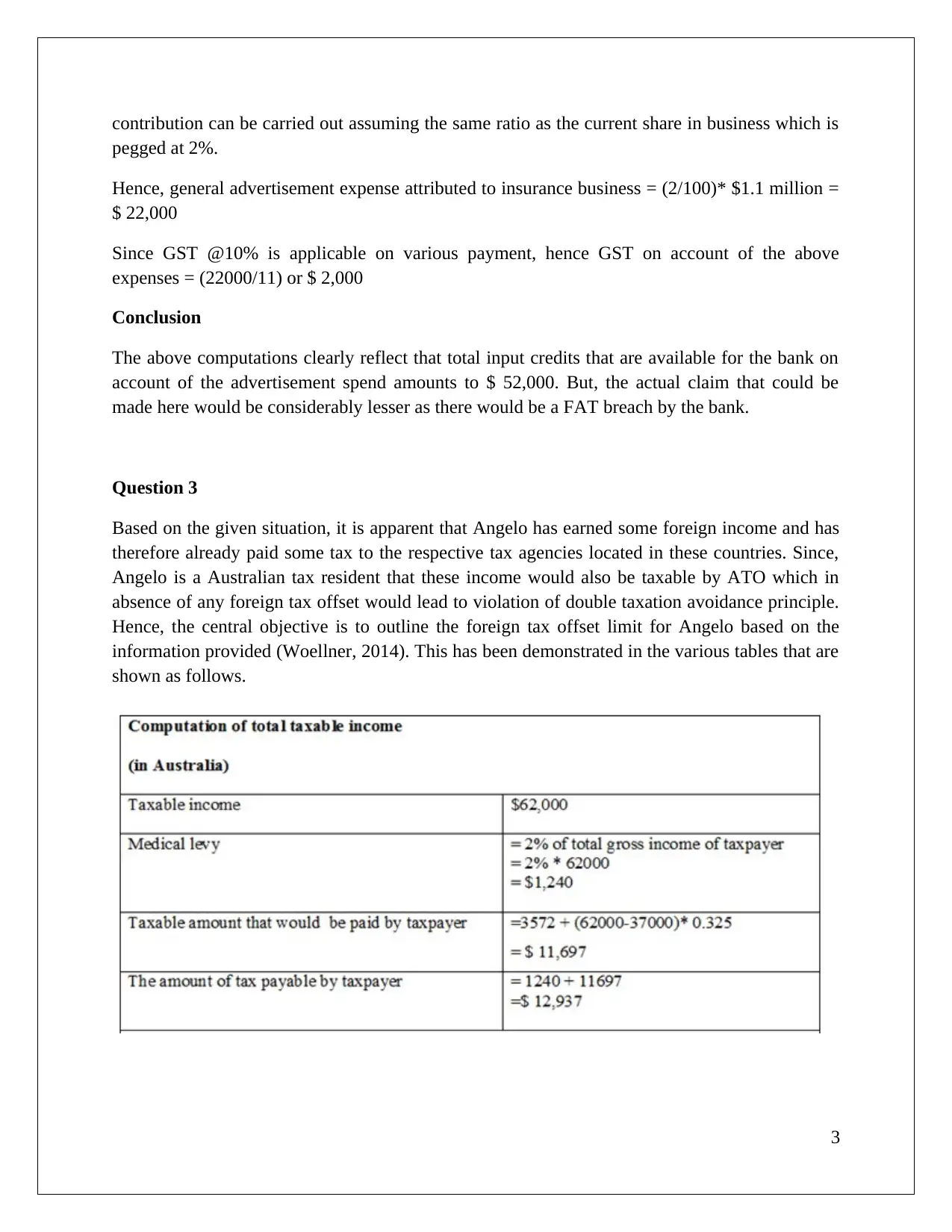
contribution can be carried out assuming the same ratio as the current share in business which is
pegged at 2%.
Hence, general advertisement expense attributed to insurance business = (2/100)* $1.1 million =
$ 22,000
Since GST @10% is applicable on various payment, hence GST on account of the above
expenses = (22000/11) or $ 2,000
Conclusion
The above computations clearly reflect that total input credits that are available for the bank on
account of the advertisement spend amounts to $ 52,000. But, the actual claim that could be
made here would be considerably lesser as there would be a FAT breach by the bank.
Question 3
Based on the given situation, it is apparent that Angelo has earned some foreign income and has
therefore already paid some tax to the respective tax agencies located in these countries. Since,
Angelo is a Australian tax resident that these income would also be taxable by ATO which in
absence of any foreign tax offset would lead to violation of double taxation avoidance principle.
Hence, the central objective is to outline the foreign tax offset limit for Angelo based on the
information provided (Woellner, 2014). This has been demonstrated in the various tables that are
shown as follows.
3
pegged at 2%.
Hence, general advertisement expense attributed to insurance business = (2/100)* $1.1 million =
$ 22,000
Since GST @10% is applicable on various payment, hence GST on account of the above
expenses = (22000/11) or $ 2,000
Conclusion
The above computations clearly reflect that total input credits that are available for the bank on
account of the advertisement spend amounts to $ 52,000. But, the actual claim that could be
made here would be considerably lesser as there would be a FAT breach by the bank.
Question 3
Based on the given situation, it is apparent that Angelo has earned some foreign income and has
therefore already paid some tax to the respective tax agencies located in these countries. Since,
Angelo is a Australian tax resident that these income would also be taxable by ATO which in
absence of any foreign tax offset would lead to violation of double taxation avoidance principle.
Hence, the central objective is to outline the foreign tax offset limit for Angelo based on the
information provided (Woellner, 2014). This has been demonstrated in the various tables that are
shown as follows.
3
Paraphrase This Document
Need a fresh take? Get an instant paraphrase of this document with our AI Paraphraser
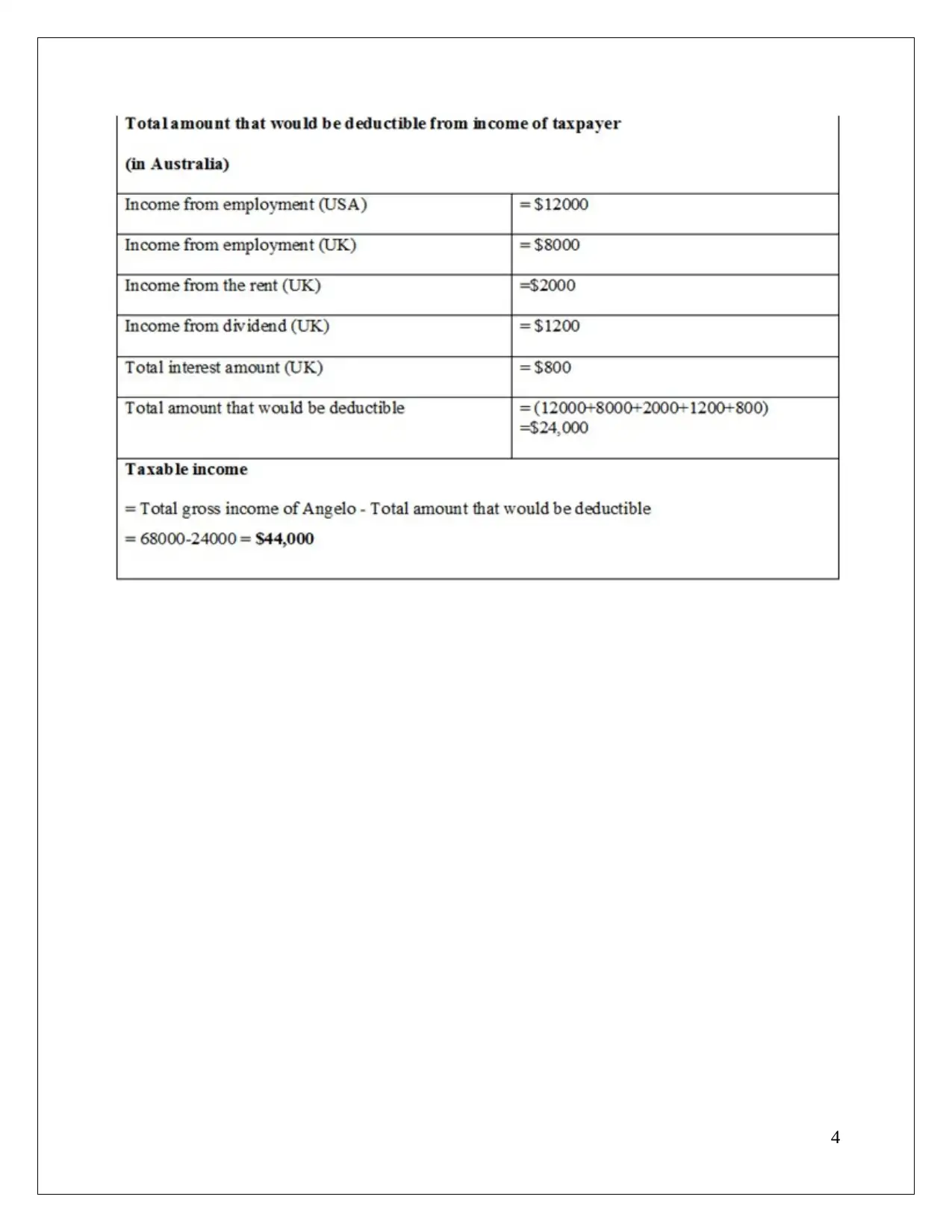
4
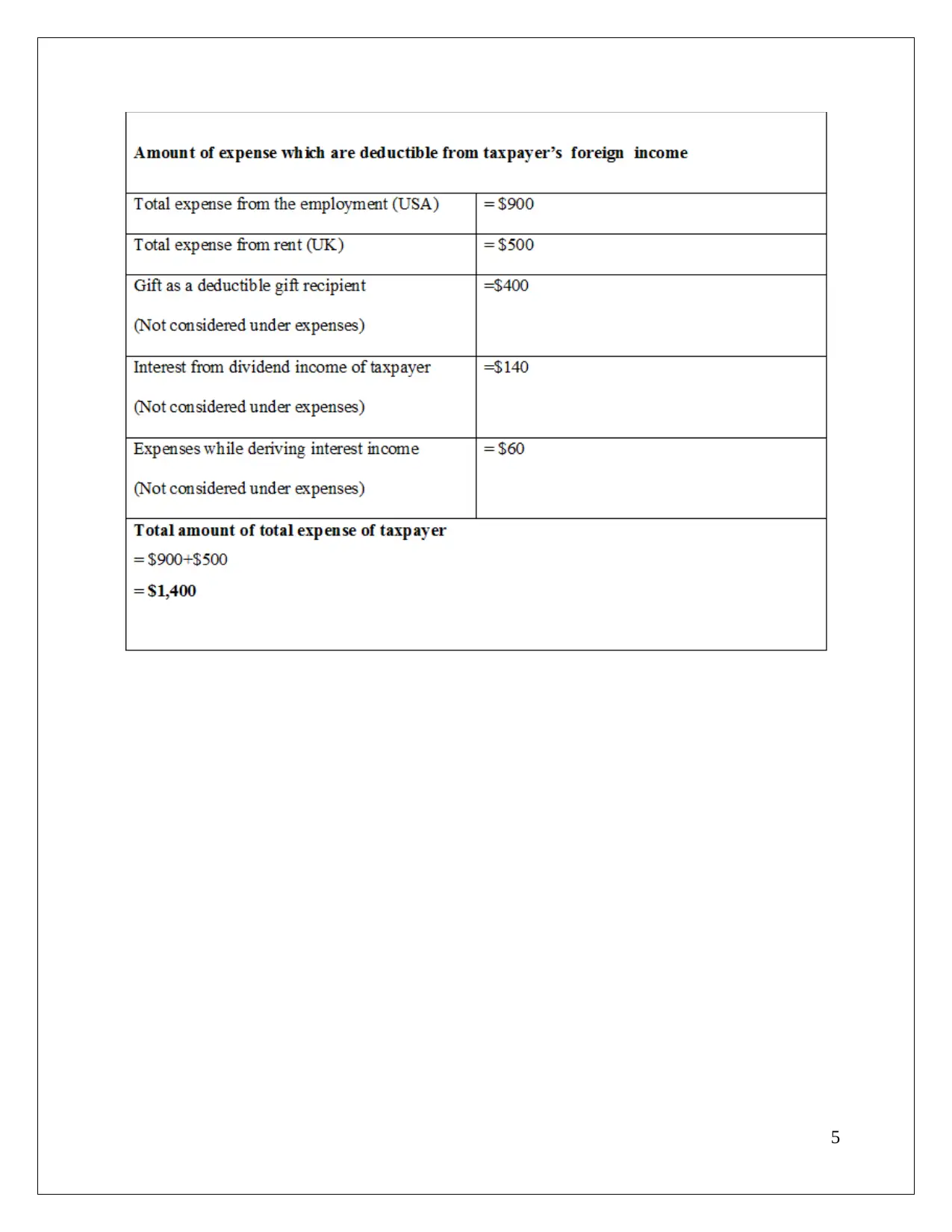
5
⊘ This is a preview!⊘
Do you want full access?
Subscribe today to unlock all pages.

Trusted by 1+ million students worldwide
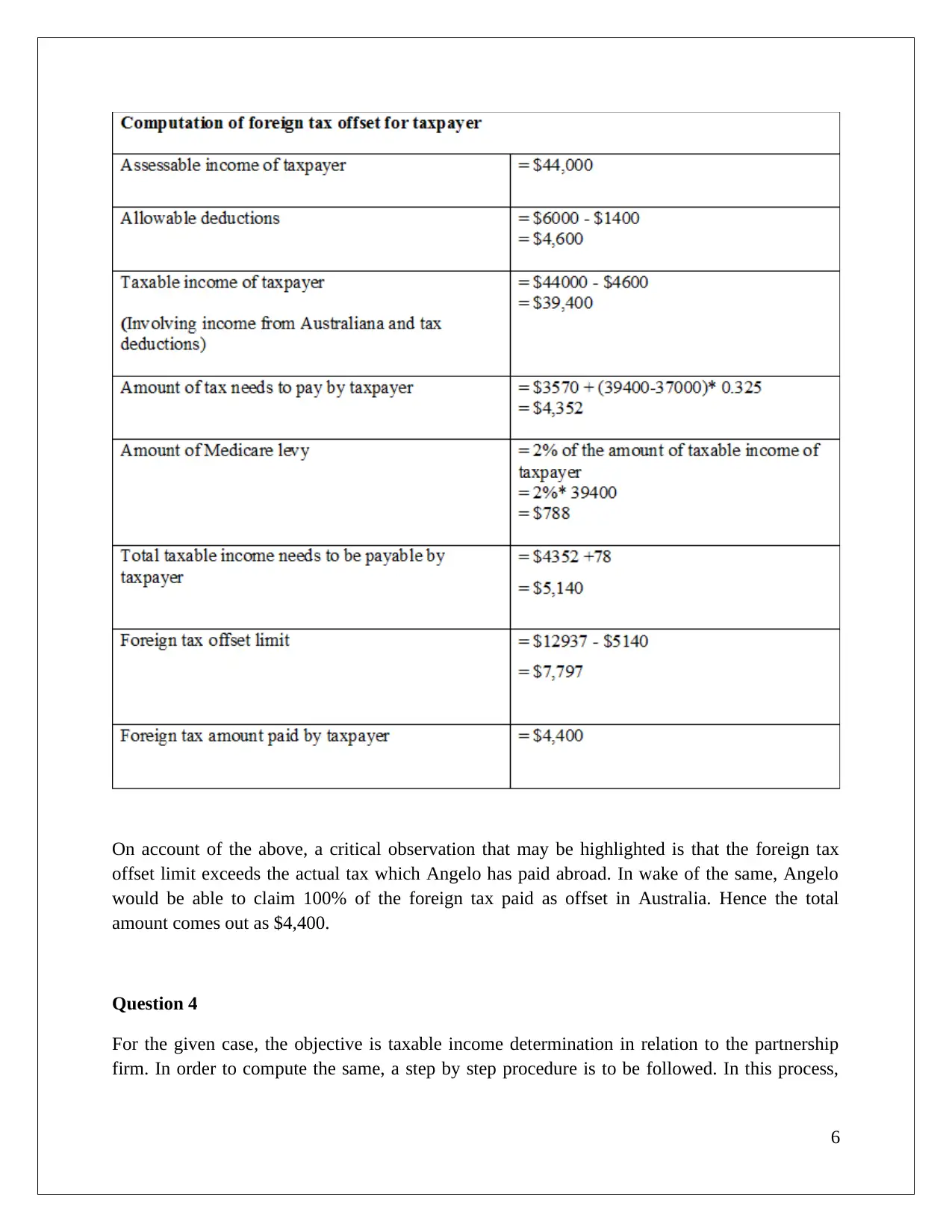
On account of the above, a critical observation that may be highlighted is that the foreign tax
offset limit exceeds the actual tax which Angelo has paid abroad. In wake of the same, Angelo
would be able to claim 100% of the foreign tax paid as offset in Australia. Hence the total
amount comes out as $4,400.
Question 4
For the given case, the objective is taxable income determination in relation to the partnership
firm. In order to compute the same, a step by step procedure is to be followed. In this process,
6
offset limit exceeds the actual tax which Angelo has paid abroad. In wake of the same, Angelo
would be able to claim 100% of the foreign tax paid as offset in Australia. Hence the total
amount comes out as $4,400.
Question 4
For the given case, the objective is taxable income determination in relation to the partnership
firm. In order to compute the same, a step by step procedure is to be followed. In this process,
6
Paraphrase This Document
Need a fresh take? Get an instant paraphrase of this document with our AI Paraphraser
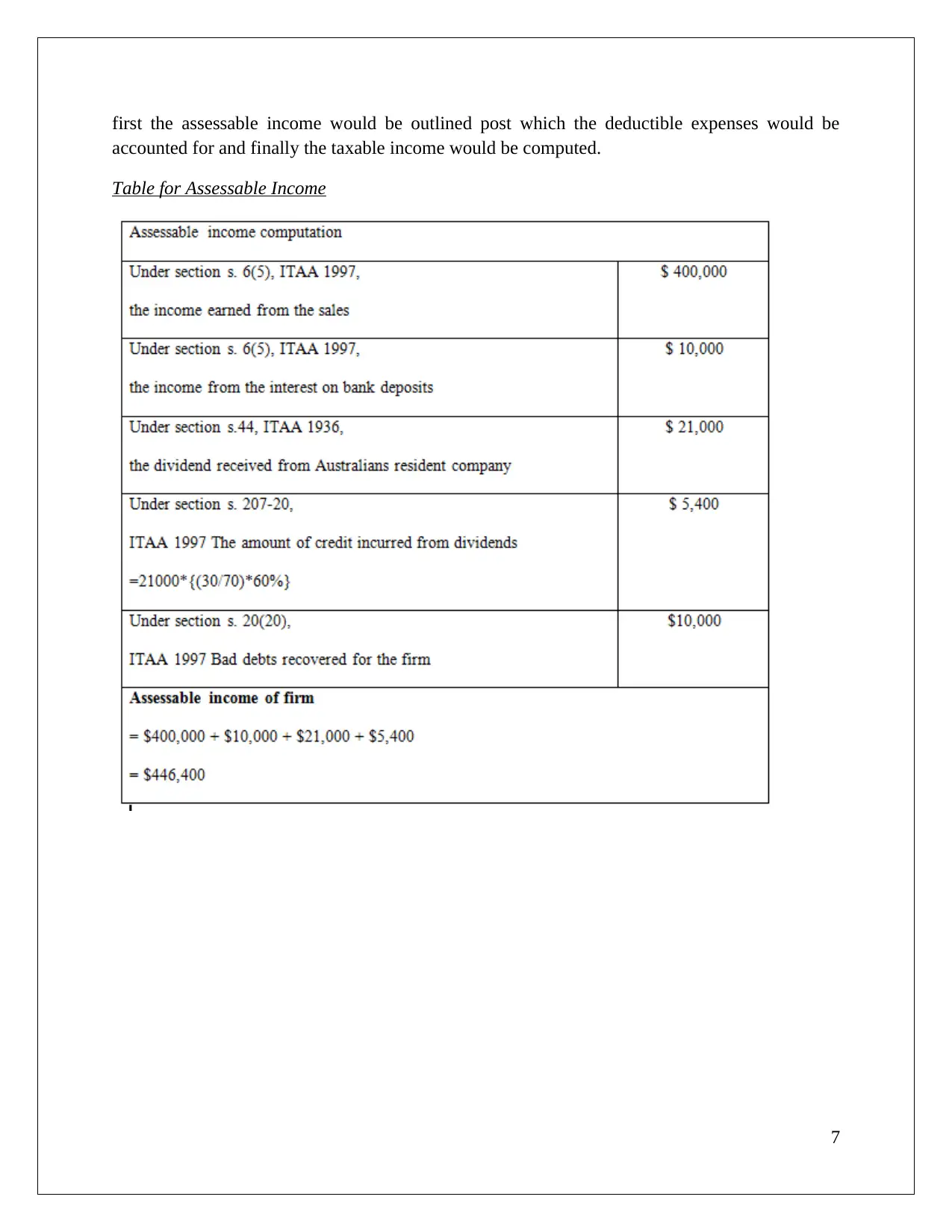
first the assessable income would be outlined post which the deductible expenses would be
accounted for and finally the taxable income would be computed.
Table for Assessable Income
7
accounted for and finally the taxable income would be computed.
Table for Assessable Income
7
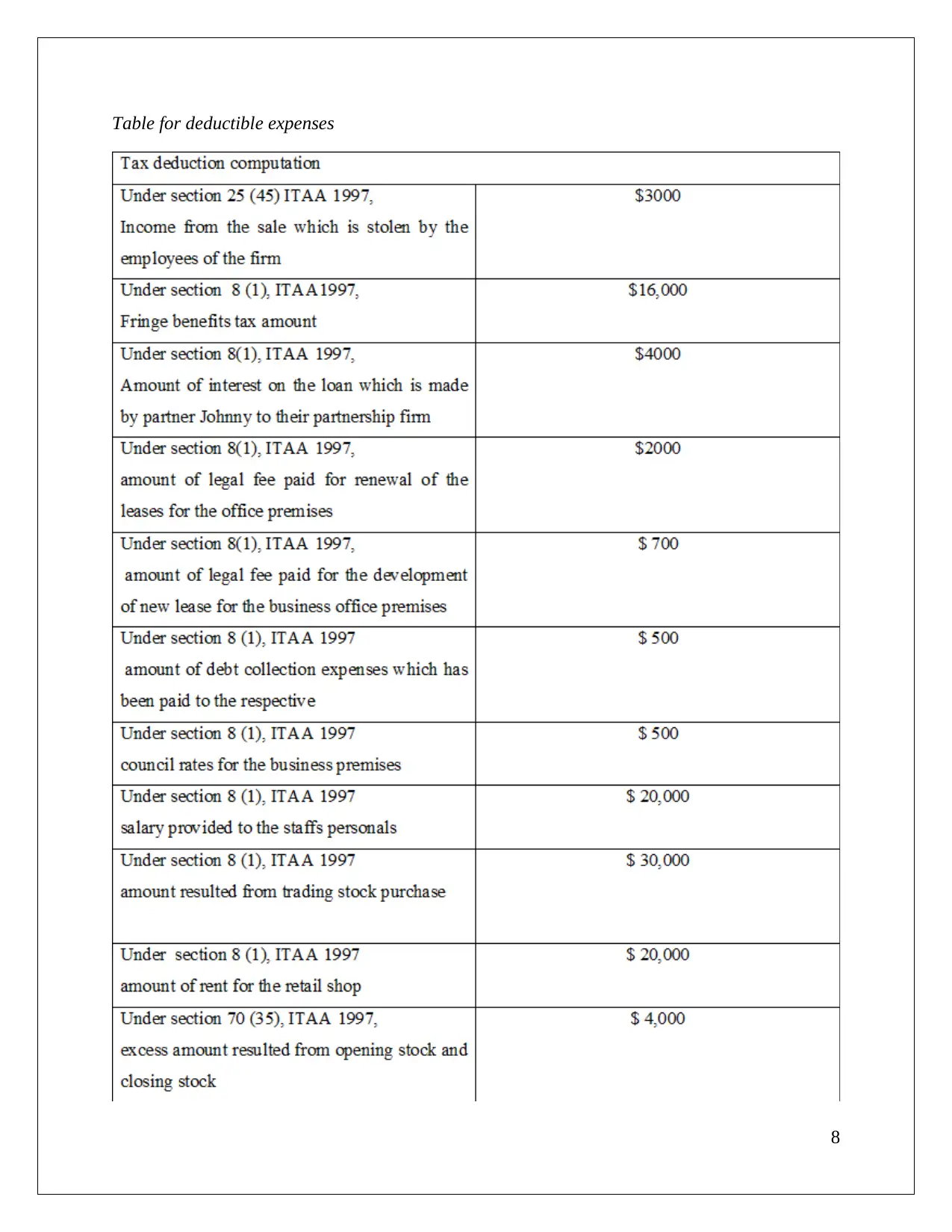
Table for deductible expenses
8
8
⊘ This is a preview!⊘
Do you want full access?
Subscribe today to unlock all pages.

Trusted by 1+ million students worldwide
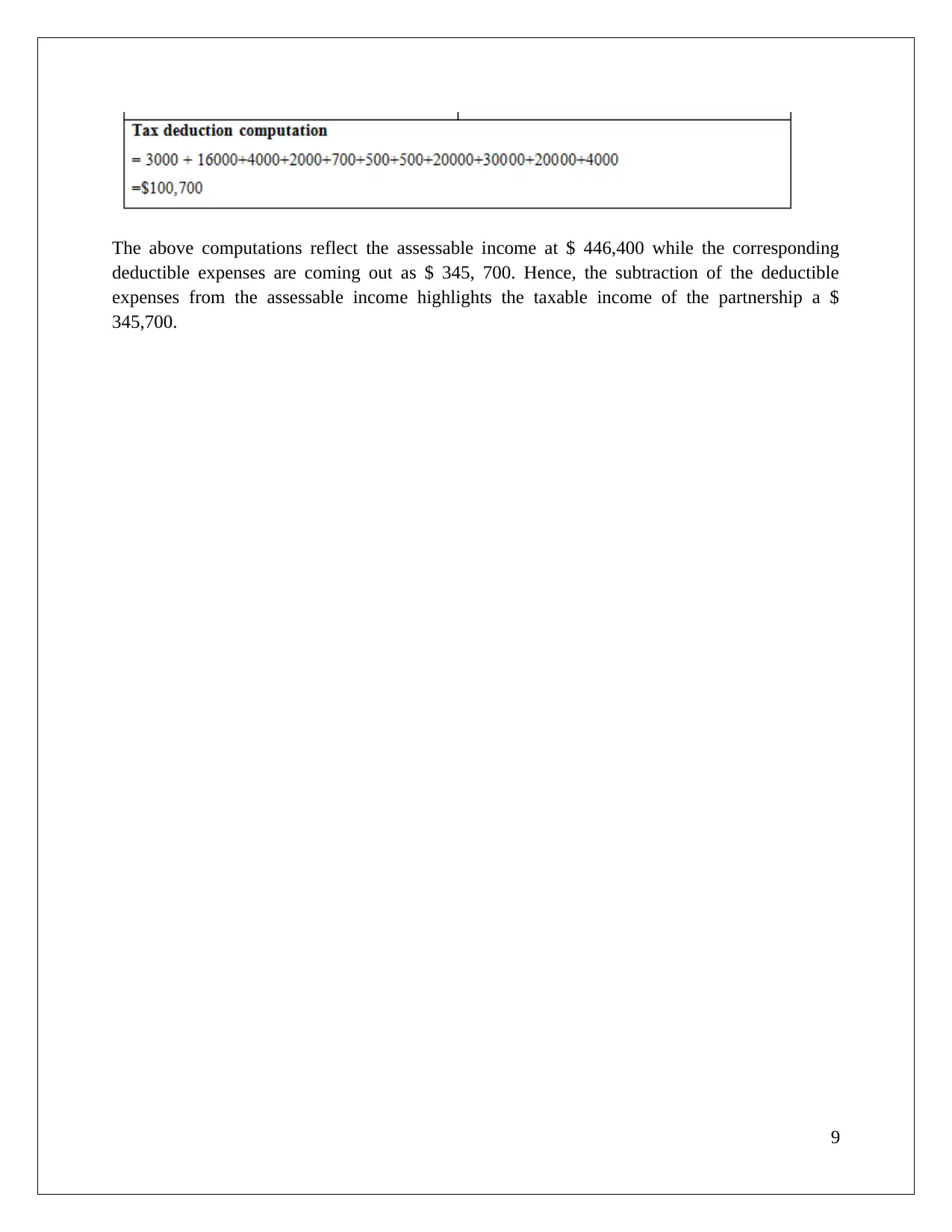
The above computations reflect the assessable income at $ 446,400 while the corresponding
deductible expenses are coming out as $ 345, 700. Hence, the subtraction of the deductible
expenses from the assessable income highlights the taxable income of the partnership a $
345,700.
9
deductible expenses are coming out as $ 345, 700. Hence, the subtraction of the deductible
expenses from the assessable income highlights the taxable income of the partnership a $
345,700.
9
Paraphrase This Document
Need a fresh take? Get an instant paraphrase of this document with our AI Paraphraser
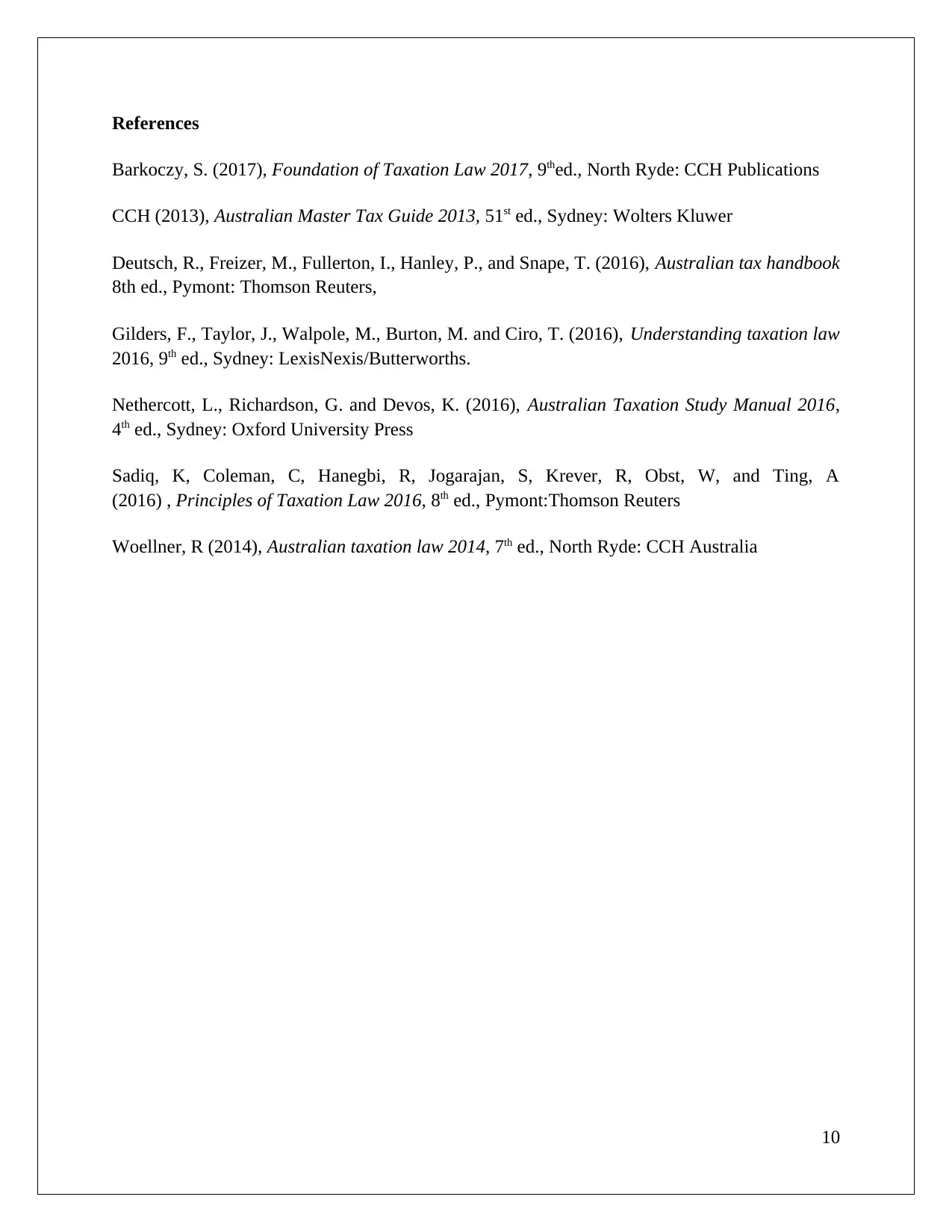
References
Barkoczy, S. (2017), Foundation of Taxation Law 2017, 9thed., North Ryde: CCH Publications
CCH (2013), Australian Master Tax Guide 2013, 51st ed., Sydney: Wolters Kluwer
Deutsch, R., Freizer, M., Fullerton, I., Hanley, P., and Snape, T. (2016), Australian tax handbook
8th ed., Pymont: Thomson Reuters,
Gilders, F., Taylor, J., Walpole, M., Burton, M. and Ciro, T. (2016), Understanding taxation law
2016, 9th ed., Sydney: LexisNexis/Butterworths.
Nethercott, L., Richardson, G. and Devos, K. (2016), Australian Taxation Study Manual 2016,
4th ed., Sydney: Oxford University Press
Sadiq, K, Coleman, C, Hanegbi, R, Jogarajan, S, Krever, R, Obst, W, and Ting, A
(2016) , Principles of Taxation Law 2016, 8th ed., Pymont:Thomson Reuters
Woellner, R (2014), Australian taxation law 2014, 7th ed., North Ryde: CCH Australia
10
Barkoczy, S. (2017), Foundation of Taxation Law 2017, 9thed., North Ryde: CCH Publications
CCH (2013), Australian Master Tax Guide 2013, 51st ed., Sydney: Wolters Kluwer
Deutsch, R., Freizer, M., Fullerton, I., Hanley, P., and Snape, T. (2016), Australian tax handbook
8th ed., Pymont: Thomson Reuters,
Gilders, F., Taylor, J., Walpole, M., Burton, M. and Ciro, T. (2016), Understanding taxation law
2016, 9th ed., Sydney: LexisNexis/Butterworths.
Nethercott, L., Richardson, G. and Devos, K. (2016), Australian Taxation Study Manual 2016,
4th ed., Sydney: Oxford University Press
Sadiq, K, Coleman, C, Hanegbi, R, Jogarajan, S, Krever, R, Obst, W, and Ting, A
(2016) , Principles of Taxation Law 2016, 8th ed., Pymont:Thomson Reuters
Woellner, R (2014), Australian taxation law 2014, 7th ed., North Ryde: CCH Australia
10
1 out of 11
Related Documents
Your All-in-One AI-Powered Toolkit for Academic Success.
+13062052269
info@desklib.com
Available 24*7 on WhatsApp / Email
![[object Object]](/_next/static/media/star-bottom.7253800d.svg)
Unlock your academic potential
Copyright © 2020–2025 A2Z Services. All Rights Reserved. Developed and managed by ZUCOL.





